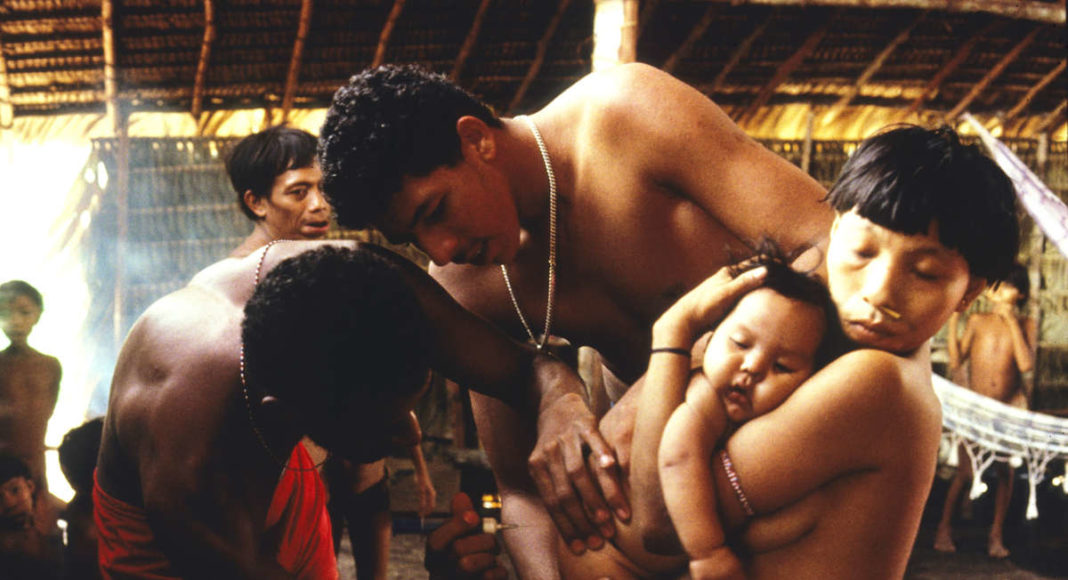This article is part of the series: Dispatches from the pandemic, published on Somatosphere.
Main image: CCPY doctor examines a sick Yanomami child, Balaú, Brazil. Image: Fiona Watson/Survival
Two weeks ago, Kanari Kuikuro called me from Canarana, a small town in the Brazilian Amazon, where he now lives with his wife and many children. He is originally from the Xingu Indigenous Land, which lies up north and is one of the most culturally rich multiethnic constellation of South America. Kanari was apprehensive.
– Pamü (cousin), we’re afraid. We wanted to go back to the village, but now our Land is closed.
– Pamü, don’t risk it. You can only go back if you go into quarantine. It’s a serious disease.
– I know, pamü, it’s like the measles from the time of my grandfather Agatsipá.

When I met Agatsipá he was quite old, but his mind was still keen, his eyes bright. He was a brilliant storyteller, and lived a long life. He survived the multiple outbreaks and epidemics that struck the population of the Upper Xingu during the 20th century. The 1954 measles epidemic is the most remembered to this day. It was brutal and quick, scything through whole families at once, leaving no time to properly bury the dead. With all those around falling sick, there was nobody left to provide for food, much less see to the bodies. Vultures swarmed and people scattered, carrying the disease elsewhere.
Indigenous peoples know the story well. Since the start of the colonization process, they have learned in their flesh what epidemics are. Smallpox, measles, chickenpox, flu. One often came on the heels of the last, never giving survivors a chance to recover. The Jesuit José de Anchieta wrote that in 1562, an epidemic killed 30,000 Tupi Indians around Todos os Santos Bay; the next year, smallpox carried off many survivors, and hunger decimated the rest of the population. Plague by plague, the bay was depopulated. In 1580, Anchieta wrote: “the number of peoplethat have been wasted [in Bahia] over the last twenty years is scarcely believable; no one imagined that so many could be consumed at once, much less in so short a time.”
The same story repeated itself many times across different regions of what would come to be Brazil. A few were preserved in written memory. Father João Bettendorf, for example, recounts an outbreak of “pox” in Pará, in 1695, which was followed by a torrent of other diseases: “Once the pox was entirely gone, there came terrible colds, of which many Indians died […] and there also came some sort of measles which killed many and lasted for months upon months.”
Most of these health crises, however, raged far from the eyes and the quills of missionaries, travelers, and colonial administrators. When we look at the archaeological record in the Upper Xingu, where the Kuikuro and other Indigenous peoples live, we can observe a break, starting in the 17th century. The many large, fortified villages that existed at the time slide into a clear decline. The Indigenous population in the region may have been 10 or 20 times larger than it is today, standing at some 50,000 to 100,000 people. However, in the early 17th century, something happened, and the large villages were abandoned. The most reasonable hypothesis posits a demographic crisis sparked by a series of epidemics, smallpox chief among them. Not only is smallpox exceptionally lethal, but its window of transmission is also broad. Asymptomatic bearers fled from death in contaminated villages, carrying what the chroniclers called “the pestilential ill” deeper into the countryside. That way, smallpox must have made it to the Upper Xingu many decades before the first Indian slave-hunters arrived in the 18th century.
These epidemics were followed by others, many of them recounted today by those who live in the Xingu in the form of narratives that weave between history and myth but are invariably tragic. The 1954 measles epidemic, however, is unquestionably the 1954 measles epidemic. The Xinguanos know very well what happened, and they know that if medical aid, and, above all, food, had arrived earlier, lives would have been spared. But resources were scarce, communication was patchy, and obstacles were myriad. And, as in the pandemic we face today, there was no vaccine.
It was vaccination programs that, starting in 1970, began to slowly invert the curve of Indigenous population decline. Their numbers rose haltingly after over four centuries of demographic losses. The key was threefold: vaccines, medical treatment, and the preservation of territory. Demarcation of Indigenous lands after the 1988 Constitution and the creation of Indigenous Sanitary Districts in 1999 are key landmarks in this struggle for life.
All of that is imperiled today: not only because we have no vaccine and no viable treatment against this new virus, but also because we lack a government fit for the challenge. The Brazilian government seems to be flirting with death, ignoring the obvious. “It’s like the measles from the time of my grandfather,” as Kanari Kuikuro reminds us. Unburied bodies in the streets, endless deaths in the villages. We must take urgent health measures to defend Indigenous peoples and their lands. We cannot see another genocide.
Kanu, one of the greatest singers in the Upper Xingu and the main character in our documentary The Hyper Women, sends me a voice message: “We’re afraid, but we’re all right. The disease hasn’t made it here yet.” One more day of relief. For how long?
Translated by Flora Thomson-Deveaux
Carlos Fausto is Professor of Anthropology at the National Museum of the Federal University of Rio de Janeiro, Brazil, and a Global Scholar at Princeton University. He is the author of Warfare and Shamanism in Amazonia and Art Effects: Image, Agency and Ritual in Amazonia.

